Acid Stability of the Hemagglutinin Protein Regulates H5N1 Influenza Virus Pathogenicity
Highly pathogenic avian influenza viruses of the H5N1 subtype continue to threaten agriculture and human health. Here, we use biochemistry and x-ray crystallography to reveal how amino-acid variations in the hemagglutinin (HA) protein contribute to the pathogenicity of H5N1 influenza virus in chickens. HA proteins from highly pathogenic (HP) A/chicken/Hong Kong/YU562/2001 and moderately pathogenic (MP) A/goose/Hong Kong/437-10/1999 isolates of H5N1 were found to be expressed and cleaved in similar amounts, and both proteins had similar receptor-binding properties. However, amino-acid variations at positions 104 and 115 in the vestigial esterase sub-domain of the HA1 receptor-binding domain (RBD) were found to modulate the pH of HA activation such that the HP and MP HA proteins are activated for membrane fusion at pH 5.7 and 5.3, respectively. In general, an increase in H5N1 pathogenicity in chickens was found to correlate with an increase in the pH of HA activation for mutant and chimeric HA proteins in the observed range of pH 5.2 to 6.0. We determined a crystal structure of the MP HA protein at 2.50 Å resolution and two structures of HP HA at 2.95 and 3.10 Å resolution. Residues 104 and 115 that modulate the acid stability of the HA protein are situated at the N- and C-termini of the 110-helix in the vestigial esterase sub-domain, which interacts with the B loop of the HA2 stalk domain. Interactions between the 110-helix and the stalk domain appear to be important in regulating HA protein acid stability, which in turn modulates influenza virus replication and pathogenesis. Overall, an optimal activation pH of the HA protein is found to be necessary for high pathogenicity by H5N1 influenza virus in avian species.
Published in the journal:
. PLoS Pathog 7(12): e32767. doi:10.1371/journal.ppat.1002398
Category:
Research Article
doi:
https://doi.org/10.1371/journal.ppat.1002398
Summary
Highly pathogenic avian influenza viruses of the H5N1 subtype continue to threaten agriculture and human health. Here, we use biochemistry and x-ray crystallography to reveal how amino-acid variations in the hemagglutinin (HA) protein contribute to the pathogenicity of H5N1 influenza virus in chickens. HA proteins from highly pathogenic (HP) A/chicken/Hong Kong/YU562/2001 and moderately pathogenic (MP) A/goose/Hong Kong/437-10/1999 isolates of H5N1 were found to be expressed and cleaved in similar amounts, and both proteins had similar receptor-binding properties. However, amino-acid variations at positions 104 and 115 in the vestigial esterase sub-domain of the HA1 receptor-binding domain (RBD) were found to modulate the pH of HA activation such that the HP and MP HA proteins are activated for membrane fusion at pH 5.7 and 5.3, respectively. In general, an increase in H5N1 pathogenicity in chickens was found to correlate with an increase in the pH of HA activation for mutant and chimeric HA proteins in the observed range of pH 5.2 to 6.0. We determined a crystal structure of the MP HA protein at 2.50 Å resolution and two structures of HP HA at 2.95 and 3.10 Å resolution. Residues 104 and 115 that modulate the acid stability of the HA protein are situated at the N- and C-termini of the 110-helix in the vestigial esterase sub-domain, which interacts with the B loop of the HA2 stalk domain. Interactions between the 110-helix and the stalk domain appear to be important in regulating HA protein acid stability, which in turn modulates influenza virus replication and pathogenesis. Overall, an optimal activation pH of the HA protein is found to be necessary for high pathogenicity by H5N1 influenza virus in avian species.
Introduction
Highly pathogenic avian influenza (HPAI) viruses kill up to 100% of infected poultry flocks and may cause high mortality rates when transmitted to humans [1], [2]. For example, H5N1 influenza viruses have contributed to the deaths of 331 of 565 individuals since 2003 [3] and are endemic in domestic poultry in Egypt and Indonesia [4]. The continued circulation of H5N1 and potential emergence of an H5N1 human pandemic virus remain ever-present threats.
The hemagglutinin (HA) surface glycoprotein promotes viral entry through its receptor binding and membrane fusion functions [5], and mutations in HA have been shown to modulate the pathogenicity, host range specificity, transmissibility, and pandemic potential of influenza viruses [1], [6], [7]. HA is synthesized as a trimeric HA0 protein that must be activated for membrane fusion by post-translational cleavage into a high-energy HA1/HA2 complex. The multi-basic HA0 cleavage sites of H5 and H7 HPAI viruses are recognized by ubiquitously expressed intracellular proteases, facilitating systemic virus spread and greater pathogenicity [8]–[10]. HA binds to sialic acid-containing receptors on the surfaces of host cells [5], and the specificity of receptor binding helps determine host range, with avian and human viruses preferentially binding to α(2,3) and α(2,6) sialosides, respectively [11], [12]. Upon internalization, the virus is exposed to progressively lower pH values until a threshold is reached that triggers HA to undergo irreversible conformational changes that mediate membrane fusion [13]. Mutations that modulate HA acid stability have been associated with the adaptation of influenza viruses to different host species and cell lines [14], [15], and HA acid stability has recently been identified as a potential virulence factor [16].
Some influenza viruses contain all of the known genetic elements for high pathogenicity yet are attenuated in vivo. For example, the clade 3 H5N1 isolate A/goose/Hong Kong/437-10/1999 has significantly lower replication and pathogenicity in chickens compared to the closely related isolate A/chicken/Hong Kong/YU562/2001 [17]. The attenuating amino-acid residues have been mapped to the receptor-binding sub-domain and the vestigial esterase sub-domain in the HA1 receptor-binding domain (RBD) in the HA protein. However, the HA proteins from both isolates contain markers typical of high pathogenicity including a polybasic cleavage site, identical glycosylation sites, and identical residues in the receptor-binding pocket. The goal of the current study was to determine the molecular mechanism by which the naturally occurring variations in the HA protein modulate H5N1 pathogenicity.
Results
MP and HP HA proteins have different acid stabilities
To determine how the HA proteins from the two isolates differ in their biochemical properties, the proteins were expressed in cell culture and compared for expression, cleavage, receptor binding, and activation pH (Figure 1, S1). The neuraminidase (NA) proteins were co-expressed with the HA proteins because of the known interplay between HA and NA with respect to receptor binding [18] and membrane fusion [16], [19], [20]. Western blot and flow cytometric analyses revealed no significant differences in total or cell-surface expression of the two HAs when co-expressed with NA from either isolate (Figure 1A,B and Figure S1). The ratios of cleaved (HA1+HA2) to uncleaved (HA0) species were also similar for the two HAs (Figure 1A). To investigate potential differences in avian receptor-binding avidity, we quantified the amount of chicken and turkey erythrocytes adsorbed to HA-expressing cells and found no difference (Figure 1C). Overall, these data show that the amino-acid variations in the HA and NA proteins from the MP and HP isolates do not result in substantial differences in HA protein expression, cleavage, or receptor binding.
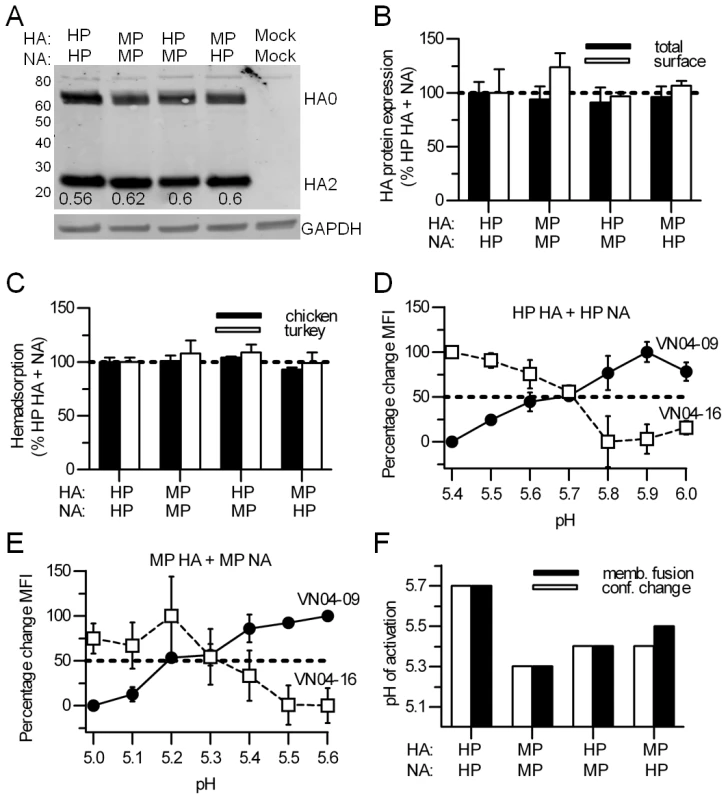
We next compared the activation pH values of the two HA proteins. Flow cytometry was used to measure pH-induced conformational changes by using monoclonal antibodies VN04-09 and VN04-16 that preferentially bind to the prefusion and postfusion forms of the H5N1 HA protein, respectively [19], [21]. When co-expressed with the homotypic NA partner, conformational changes by MP HA were first observed at pH 5.4, reached a midpoint at pH 5.3, and were complete at pH 5.1–5.2 depending on the antibody (Figure 1E). In contrast, conformational changes by HP HA were triggered at higher pH (∼0.4 pH units) being first observed at pH 5.8, reaching a midpoint at pH 5.7, and being complete at approximately pH 5.4 (Figure 1D). Comparing the midpoints of conformational changes, MP HA had a value of pH 5.3 whereas HP HA had a value of 5.7, showing that HP HA is less acid stabile than MP HA. To determine the highest pH at which the HA proteins promote membrane fusion, syncytia assays were performed in BHK-21 cells. Consistent with the flow cytometry results, MP HA triggered membrane fusion at pH 5.3 when co-expressed with its MP NA partner, and HP HA triggered fusion at pH 5.7 when co-expressed with its HP NA partner (Figure 1F). The syncytia assays were repeated using BHK-21 cells infected with the MP 437-10 and HP YU562 viruses. In virus-infected cells, MP HA was activated to cause membrane fusion at pH 5.2, and HP HA promoted membrane fusion at pH 5.6. Therefore, during either infection or transient expression, HP HA was destabilized by 0.4 pH units compared to MP HA.
We have recently shown that NA enzymatic activity increases the activation pH of the H5N1 HA protein [16]. Therefore, we next investigated whether potential differences in the activities of NA proteins from the HP YU562 and MP 437-10 viruses might affect HA acid stability. We first measured the activities of HP and MP NA when transiently co-expressed with their homotypic HA protein and found that HP NA had significantly more activity than MP NA (P<0.05; unpaired two-tailed t test) (Figure 2A). Second, we measured the NA activities of HP and MP viruses in vitro and found once again that the HP virus had significantly more NA activity than the MP virus (P<0.01; unpaired two-tailed t test) (Figure 2B). Third, we measured the pH of activation of the HAs when co-expressed with either the HP or MP NA protein (Figure 1F). MP HA was activated at a higher pH of 5.45 when co-expressed with the more active, heterotypic HP NA compared to co-expression with the less active, homotypic MP NA (pH of 5.3). HP HA was activated at a lower pH of 5.4 when co-expressed with the less active, heterotypic MP NA compared to co-expression with the more active, homotypic HP NA (pH of 5.7). In summary, we found that the HA protein from the HP YU562 virus was activated at a higher pH than the HA protein from the MP 437-10 virus, and increased NA activity from the HP YU562 virus was associated with a further increase in the pH of HA activation.
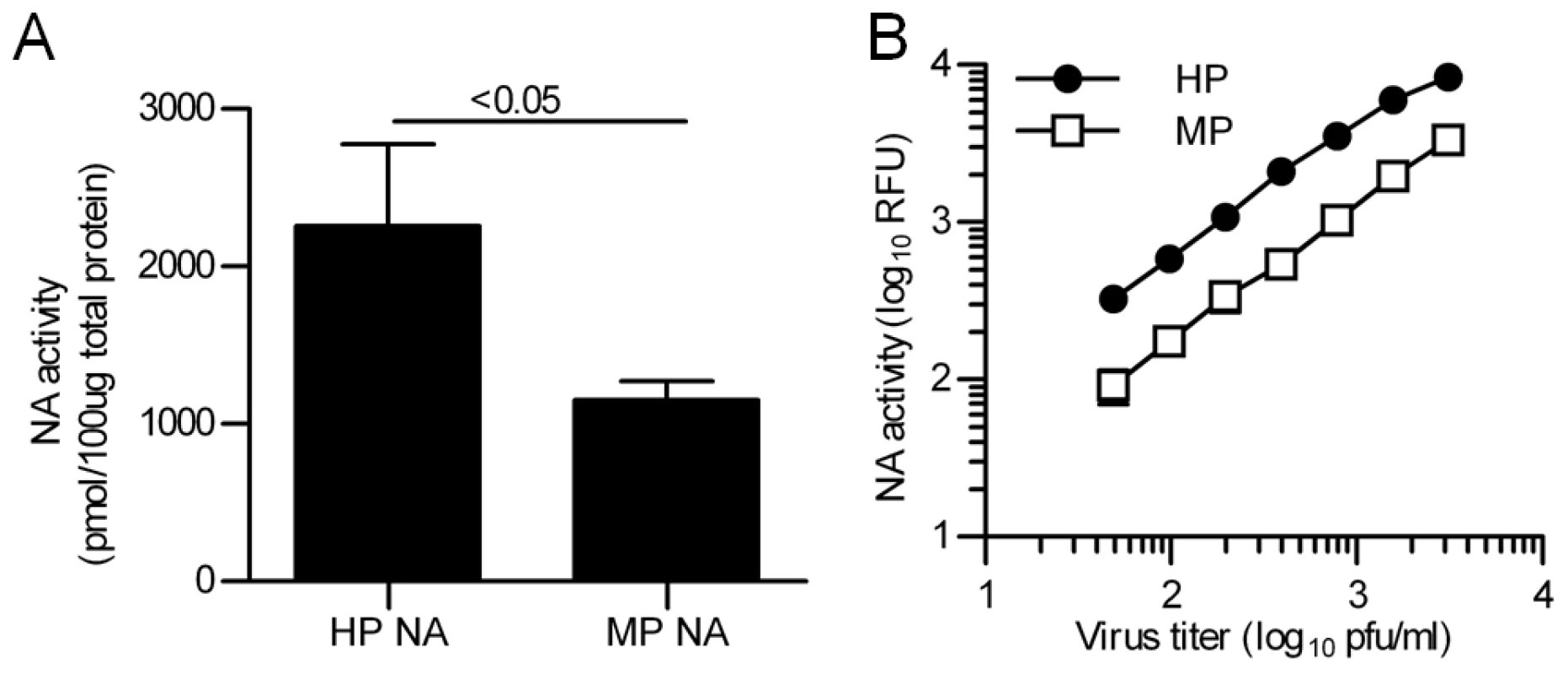
Residues that regulate HA acid stability
The HA proteins of MP 437-10 and HP YU562 viruses differ by 7 amino-acid residues in HA1. Residues 104 and 115 are at the ends of the 110-helix in the vestigial esterase sub-domain of the RBD, 131 and 142 are distal to the receptor-binding pocket in the receptor-binding sub-domain, 216 and 221 are at the interface of receptor-binding sub-domain protomers, and 331 is within the polybasic cleavage site [17]. To identify the residues that are responsible for altering HA acid stability, we introduced mutations into the HP HA that correspond to those found in the MP HA, either individually or in combination. We introduced the mutations into the HP HA, rather than vice versa, because chicken LD50 values for influenza viruses containing analogous mutations were previously made in the background of the 8 gene segments of the HP virus [17]. We then measured the biochemical properties of the mutant HP HA proteins when co-expressed with the homotypic HP NA protein. We initially focused on three chimeric HP HA proteins: rHA1 (D104N/I115T/E131D/L142H), rHA3 (K216E/S221P), and rHA5 (E331K). None of the three chimeric proteins displayed altered levels of expression, cleavage, or receptor-binding avidity of the HP HA protein (Figure 3). The E331K mutation in the polybasic cleavage site of rHA5 did not affect the HA activation pH (Figure 3A). The mutant HP HA protein containing K216E/S221P mutations (rHA3) was also not responsible for decreasing the pH of activation, but instead had the opposite effect by raising the pH of activation of the HP HA protein to 6.0 (Figure 3A) due to the presence of the K216E mutation (Figure S2).
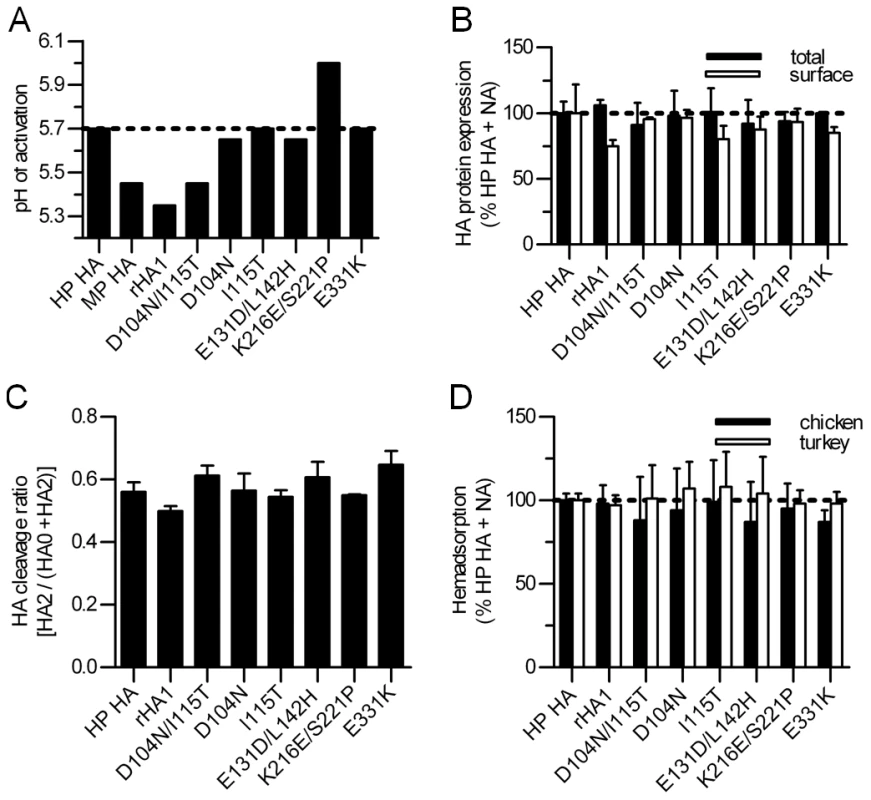
The rHA1 chimeric HP HA protein containing 4 mutations (D104N/I115T/E131D/L142H) was previously shown to reduce the pathogenicity of HP YU562 virus in chickens [17], and in this study we found that the rHA1 mutations reduced the activation pH of HP HA from 5.7 to 5.35 (Figure 3A), a value similar to that of MP HA. To identify the responsible residue(s), we generated HP HA proteins that contained either single (D104N, I115T, E131D, or L142H) or double (D104N/I115T or E131D/L142H) mutations. A reduced activation pH was only present in the D104N/I115T double mutant, which was triggered at pH 5.45, a value identical to that of the MP HA protein when co-expressed with the HP NA protein (Figure 3). Therefore, our data suggest that changes at residues 104 and 115 contribute to the difference in the activation pH values of the HP and MP HA proteins.
Relationship between HA acid stability and H5N1 pathogenicity
We next compared our measurements of HA activation pH to the values of 50% lethal dose (LD50) in chickens that had been infected with H5N1 viruses containing equivalent HA mutations [17]. An increase in the pH of activation of the HA protein correlated (R2 = 0.82) with an increase in pathogenicity, represented as the reciprocal of LD50 (Figure 4). HP HA and rHA3 (K216E/S221P) had relatively high activation pH values of 5.7 and 6.0, respectively, and promoted the most pathogenicity in chickens with the lowest LD50 values of 0.1 and 0.02 log10 EID50/mL, respectively. All of the HAs that had activation pH values less than 5.5 promoted reduced pathogenicity in chickens, resulting in LD50 values greater than 0.5 log10 EID50/mL. For HP HA, the presence of the more-active HP NA resulted in an activation pH of 5.7 and an LD50 value of 0.1 EID50/mL, whereas the presence of the less-active MP NA decreased the activation pH to 5.4 and lowered the pathogenicity to an LD50 value of 0.67 EID50/mL. Conversely for MP HA, the presence of the less-active MP NA resulted in an activation pH of 5.3 and an LD50 value of 3.7 EID50/mL, whereas the presence of the more-active HP NA increased the activation pH to 5.45 and enhanced the pathogenicity to an LD50 value of 1.7 EID50/mL. In some cases when switching NA partners, the relationship between HA activation pH and pathogenicity was less pronounced. For example, the HP HA + MP NA combination resulted in an HA activation pH of 5.4 and an LD50 value of 0.67 EID50/mL while the MP HA + HP NA combination had a slightly higher activation pH of 5.45 but was less pathogenic with an LD50 value of 1.7 EID50/mL. While a loss of balance between HA's receptor-binding activity and NA's enzymatic activity [18] could potentially cause such a discrepancy when the NA partner is switched, another unidentified mechanism may play a role instead as the presence of either NA resulted in similar receptor-binding avidities for MP and HP HA (Figure 1C). Overall, though, the data reveal a trend in which an increase in the pH of activation of the HA protein is associated with increased pathogenicity in chickens within the observed pH range of 5.2 to 6.0.
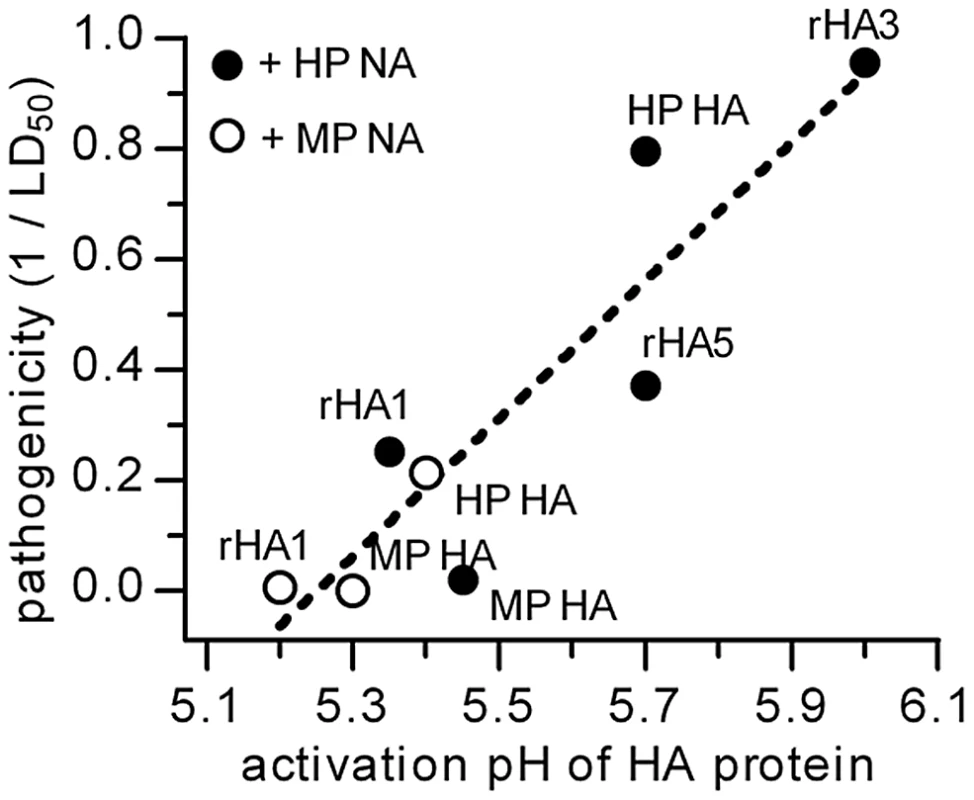
Crystal structures of H5N1 HA proteins
To gain insights into the structural basis for altered HA acid stability, we determined the crystal structures of the prefusion forms of the MP and HP HA proteins (Table 1). One crystal form of the MP HA protein was obtained at pH 8.5, and two crystal forms of the HP HA protein were obtained at pH 6.6, all above the low pH thresholds for conformational changes for the two proteins. The overall folds of the MP and HP HA proteins (H5N1 clade 3) are very similar to each other (Figures 5D and S3) and to those of the previously determined HA structures from isolates A/Vietnam/1203/04 and A/Vietnam/1194/04 (H5N1 clade 1) [22], [23]. Of the seven differing residues, 331 is in the polybasic cleavage site and is not present in the cleaved structures, 104 and 115 are within the vestigial esterase sub-domain in the RBD, and 131, 142, 216, and 221 are within the receptor-binding sub-domain in the RBD (Figure 5B,C).
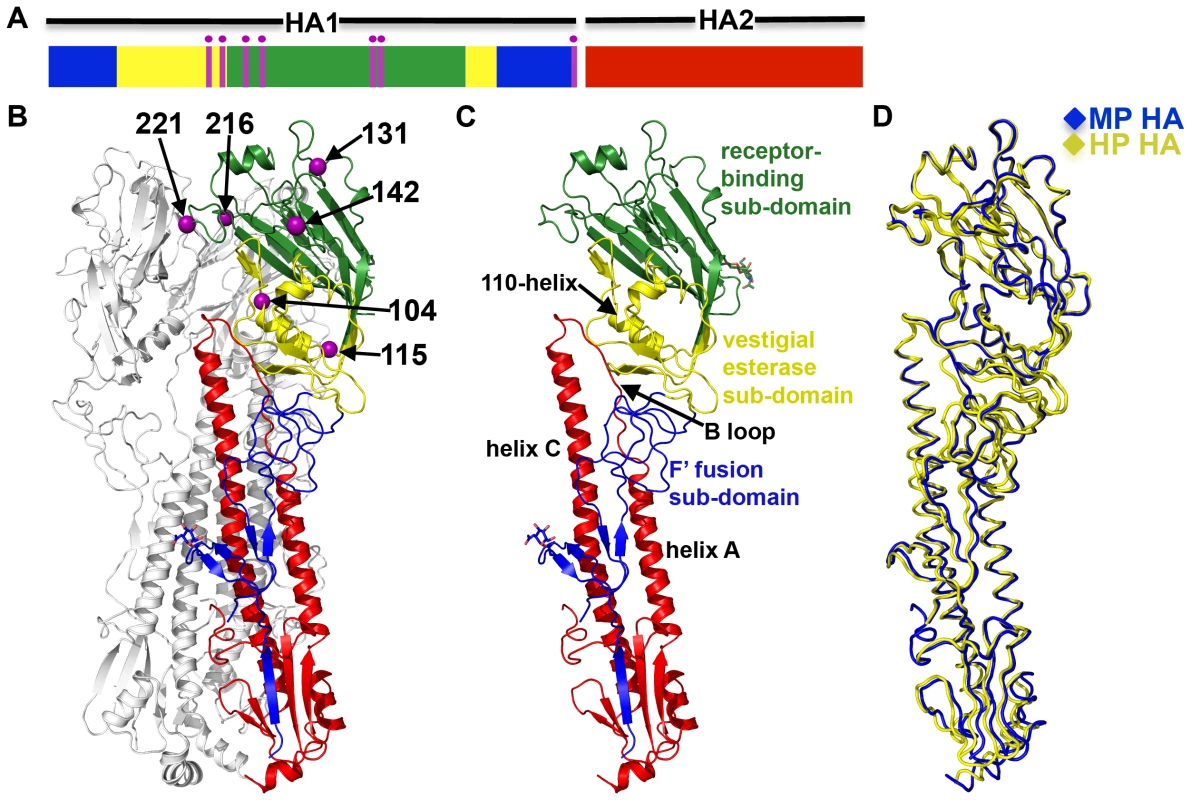
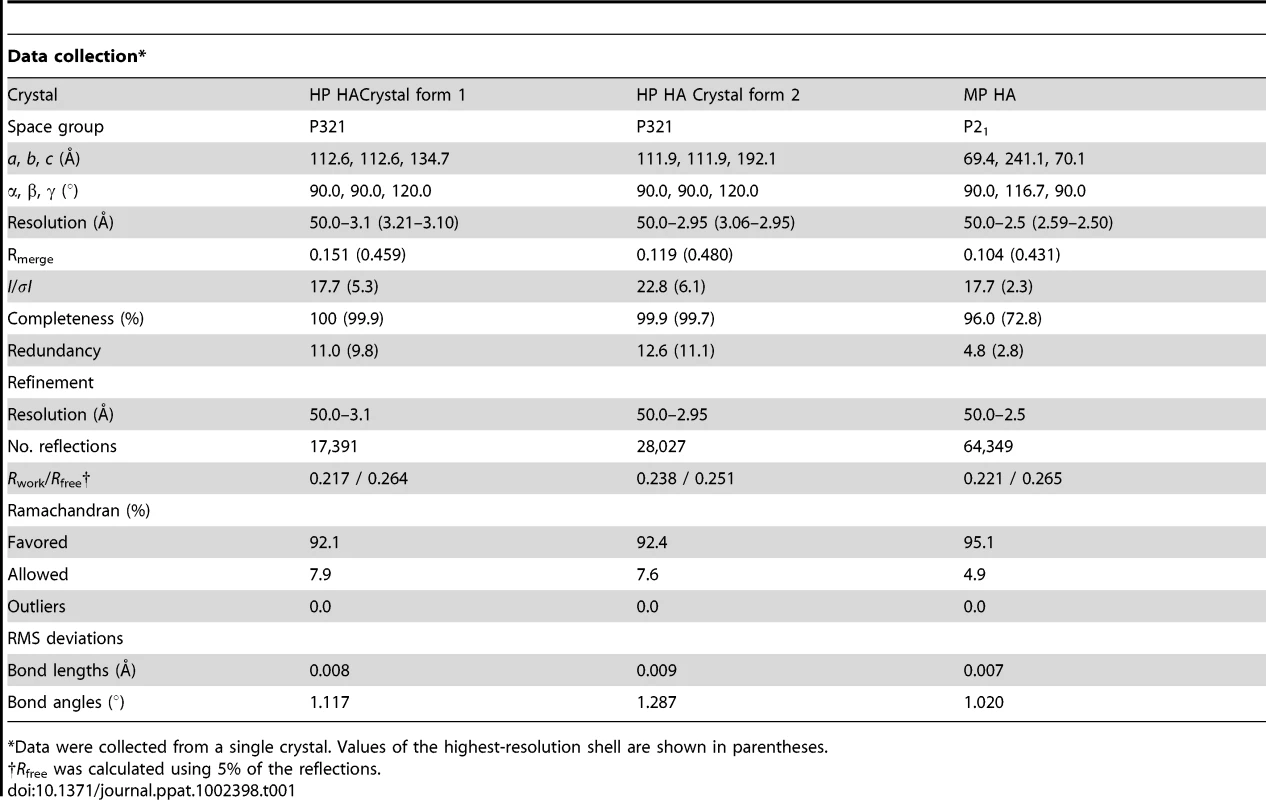
An overlay of the RBD, which includes the receptor-binding sub-domain and the vestigial esterase sub-domain, shows that the six varying residues induce no substantial differences in the α-carbon backbone structures of two prefusion HA strains (Figure 5D). The RMSD values (on α-carbons) between the RBDs of MP HA and HP HA crystal forms 1 and 2 are 0.31 Å and 0.27 Å, respectively. The receptor-binding pocket residues had no differences in conformation between the MP and HP HA structures, and mutations at residues 131 and 142 distal to the receptor-binding pocket did not alter the backbone structure (Figure S4). The most significant differences occur between the two crystal forms of the HP HA protein, specifically, in the B loops of the HA2 stalk domain along with parts of the vestigial esterase sub-domain (not including the 110-helix) and the F' fusion sub-domain (Figures 5C and S5A-C). Both crystal forms were grown in identical solutions at pH 6.6, 0.9 pH units above its activation pH of 5.7, but display different crystal-packing interactions in the B loop region. The HA2 B loops from H5N1 isolates VN1194 and VN1203 also adopt “in” and “out” forms, respectively (Figure S5F), despite both proteins having identical residues in this region and their crystals being grown at similar pH values of 6.5 and 6.55 [22], [23]. VN1203, which adopts the “out” form in the absence of antibody, adopts the “in” form when bound to antibody [24], [25] (Figure S5F). Because the various prefusion H5N1 HA proteins adopt either “in” or “out” forms of the B loop in similar conditions and with little apparent structural consequence, the apparently flexible B loop may have little functional relevance in the prefusion conformation of H5N1 HA.
Residues 216 and 221 in the receptor-binding sub-domain interact with residues in adjacent monomers across the RBD trimer interface (Figure 5B). In MP HA, E216 makes a hydrogen bond with neighboring RBD backbone amide R212 (Figure 6B), although this hydrogen bond is found only in two of the three E216 residues in the HA trimer. The lack of hydrogen bonding by the third E216 could be biologically relevant, helping to destabilize HA, or could be due to a crystallographic artifact. In HP HA, K216 makes a hydrogen bond with neighboring RBD backbone carbonyl N210 (Figure 6B). We found that a K216E mutation increased the pH of activation of HP HA by 0.4 pH units (Figure S2). However, the presence of an E216 residue did not seem to have a dominant effect in the context of MP HA, which contains six other mutations and has an overall decreased pH of fusion compared to HP HA (Figure 1). Compared to P221 in MP HA, S221 in HP HA forms a hydrogen bond to the D241 side-chain in an adjacent monomer across the RBD-RBD interface (Figure 6B). While one might have expected that a S221P mutation would destabilize HA by breaking a hydrogen bond and introducing a proline, we found that an S221P mutation had the opposite effect in the background of HP HA, decreasing the activation pH from 5.7 to 5.5 (Figure S2A). Perhaps the rigidity of a proline at residue 221 stabilizes this region. It has been previously hypothesized for H5N1 and demonstrated for H3N2 (X31 strain) that HA stability is regulated by salt bridges across the RBD-RBD interface and that an alteration in HA stability may play a role in influenza virus infectivity [26]. In the present study, the structural and biochemical results on H5N1 mutations at residues 216 and 221 show that alterations in hydrogen-bonding interactions across the RBD-RBD interface also regulate H5N1 HA acid stability (Figure 6B, S2).
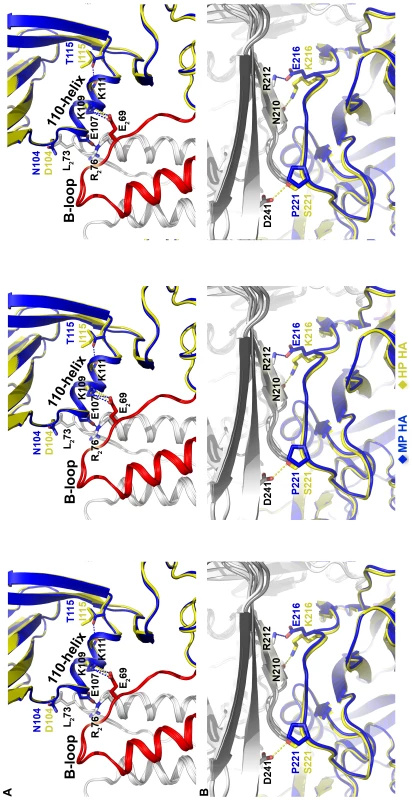
The higher activation pH of HP HA compared to MP HA was largely mapped to differences in residues 104 and 115 (Figure 3A), which are located at the N- and C-termini of the 110-helix in the vestigial esterase sub-domain of the RBD (Figure 5). In the prefusion conformation, the 110-helix in HA1 interacts with the interhelical B loops of two protomers in HA2 (Figure 6A). Most notably, HA1 residues E107 and K109 in the 110-helix form salt bridges with HA2 residues R76 and E69, respectively. This interaction may stabilize the metastable structure by preventing the B loops from springing out to their coiled-coil form or, alternatively, by stabilizing the RBD head domains to prevent their dissociation from the HA2 stalk after B loop structural changes are initiated by low pH [27]. These salt bridges are clearly important because E107 and K109 are more than 99.7% conserved amongst sequenced H5N1 HA proteins, and R76 and E69 are 100% conserved. The structures suggest that the sequence variations at residues 104 and 115 modulate the stability of the 110-helix and, consequently, the interactions between the 110-helix and the stalk domain. We hypothesize that the negatively charged D104 in HP HA forms less favorable interactions with the neighboring L73 at the top of the HA2 coil in the prefusion conformation than does the polar N104 in MP HA (Figure 6A). T115 in MP HA forms a hydrogen bond with the backbone carbonyl oxygen of L111, thereby capping and stabilizing the C-terminal end of the 110-helix. I115 in the HP HA does not form this hydrogen bond, and the stabilizing capping interaction is therefore absent. Overall, we suggest that the combination of D104N and I115T mutations found in MP HA promotes the stabilization of the 110-helix and thereby stabilizes the prefusion form of the HA protein, lowering its pH of activation and, consequently, attenuating the virus.
Discussion
The goal of the current study was to understand how amino acid variations in the HA protein contribute to differences in pathogenicity between two H5N1 influenza virus isolates. Our analyses revealed that H5N1 pathogenicity in chickens correlates with the activation pH of the HA protein. Specifically, an increase in the pH of activation of the HA protein from 5.3 to 5.7 was associated with the greater pathogenicity of the A/chicken/Hong Kong/YU562/2001 isolate in chickens compared to the A/goose/Hong Kong/437-10/1999 isolate. Other factors are largely similar including their prefusion structures, expression levels, cleavage levels, and receptor-binding properties. We have also shown that naturally occurring mutations in the HA proteins of circulating H5N1 influenza viruses have altered the acid stability of the HA protein. Six of the 7 available HA protein sequences from H5N1 viruses sampled in 1999 (Table 2), including the MP 437-10 isolate, contain the N104 and T115 residues that we found to contribute to a reduced HA activation pH and reduced pathogenicity. In contrast, none of the available 2847 HA protein sequences obtained since 2000 contain the N104/T115 combination, whereas approximately 93% contain the D104/I115 combination found in the HP YU562 isolate that leads to an increased HA activation pH and increased pathogenicity. These epidemiological observations suggest that there has been a negative selection pressure against the N104/T115 combination of residues that are found in the MP virus that has prevented its propagation in avian species, and this may be related to the relatively low pH that is required to trigger membrane fusion.
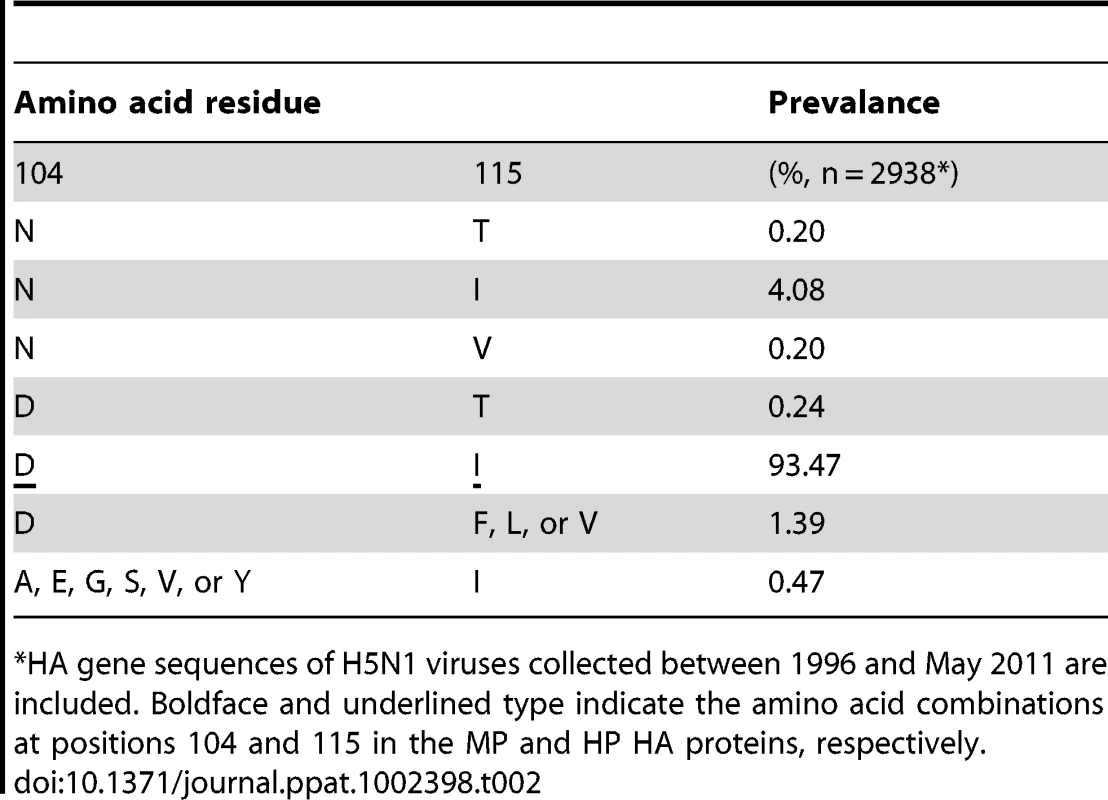
Here, we found that sequence variations in the RBD (which includes the receptor-binding and vestigial esterase sub-domains) do not alter the structure of the prefusion RBD but instead modulate the activation pH of the H5N1 HA protein. While such a phenotype may be unexpected, a D112G mutation in the HA2 stalk domain of A/Aichi/68 (H3N2) has also been shown to alter HA acid stability yet involves only the replacement of the Asp sidechain with a water molecule at the mutation site, causing no detectable changes in the backbone or surrounding protein structure in prefusion HA [28]. Further evidence that the RBD forms a stable structure in the prefusion conformation is suggested by the fact that the isolated RBD from A/H1N1/2009, E. coli-expressed and refolded [29], has recently been shown to adopt the same fold [30] as the RBD in the intact, prefusion HA ectodomain [31], [32]. The structures of a mutant H2N2 HA protein (A/Japan/305/57) determined from crystals grown at pH 8.1 and 5.3 suggest that early structural changes in HA after acid activation include bulging out of the HA2 B loop and distortions in the HA1 vestigial esterase and F' fusion sub-domains (Figure S5G-I) [27]. These reversible structural changes were suggested to correspond to an early intermediate of the HA protein after acid activation and may help initiate global HA refolding. We also observed the two forms of the B loop, vestigial esterase sub-domain, and F' fusion sub-domain in the two different crystal forms of the HP A/chicken/Hong Kong/YU562/2001 (H5N1) HA protein (Figure S5A-C), although both H5N1 HA crystals were grown in identical solutions at pH 6.6 (0.9 pH units above its pH of activation). While the two HP H5N1 HA structures suggest that the observed differences in the B loops, vestigial esterase sub-domain, and F' fusion sub-domain in the prefusion structures reported here are due to differing crystallographic environments, it is possible that upon low-pH activation the H5N1 HA protein favors the “out” form of the B loop and pivoting of the F' fusion sub-domain similar to that which is observed when the H2 HA protein is exposed to acidic pH [27].
Mutations to amino-acid residues other than 104 and 115 can modulate HA protein activation and influenza virus pathogenicity. For example, in a proof-of-concept study, we recently showed that mutations to conserved residues in the stalk domain (albeit, mutations that have not been observed in circulating H5N1 viruses) alter HA acid stability and, as a result, modulate H5N1 replication, pathogenicity, and transmissibility in ducks [16]. In that study, recombinant A/chicken/Vietnam/C58/2004 (H5N1, clade 1) viruses containing HA proteins activated at pH values of 5.6 and 5.9 were highly virulent and transmissible in mallards, while those activated at pH values of 5.4 and 6.3 were avirulent and not transmissible. Taken together, our previous [16] and present data suggest that high levels of H5N1 influenza virus infection and pathogenicity in avian species may be supported by a relatively narrow range of HA protein activation pH values, minimally pH 5.6 to 6.0.
In general, opposing pressures may limit the activation pH of the HA protein to an optimal range that may shift depending on viral and host factors. A relatively low pH of HA protein activation would be needed to avoid inactivation in the environment or in mildly acidic tissues, whereas the activation pH would still need to be high enough to allow membrane fusion to occur before the virus is trafficked to the lysosome. Circumstantial and direct evidence support this notion. First, the acid stabilities of influenza virus HA proteins range from pH 4.6 to 6.0 and vary by subtype and host species [33]. Second, the adaptation of H3N2 viruses from eggs to mammalian cells [15] and of H7N3 viruses from ducks to turkeys [14] resulted in HA mutations that altered the acid stability of the HA protein. Third, in the presence of high concentrations of amantadine, a compound that raises endosomal pH, resistant variants of H3N2, H7N1, and H7N7 viruses have been selected that have increased HA activation pH values [34]–[37].
In the present work, a higher level of NA enzymatic activity contributed to an increase in the activation pH of the HA protein and was associated with greater virulence by HP YU562 virus compared to MP 437–10 virus. Compared to expression of HA alone, coexpression of NA together with HA has previously been shown to increase the pH of activation of the H5N1 HA protein by 0.5 pH units in the absence but not the presence of the NA inhibitor oseltamivir [16], further demonstrating a link between NA activity and destabilization of the HA protein. The mechanism by which NA enzymatic activity augments HA protein fusogenic activity is unknown; however, cleavage of sialic-acid containing N-linked glycosylation sites on the HA protein may decrease the energy required to trigger HA conformational changes by destabilizing the prefusion form of individual HA trimers. Alternatively, enhanced cleavage of HA glycosylation sites could potentially promote the synchronized activation and refolding of adjacent, interacting HA trimers [38]. Increased NA enzymatic activity could also reduce interference that would occur if HA trimers bound to other HA trimers, NA proteins, glycoproteins, or glycolipids. However, a very large reduction in NA enzymatic activity might be needed to cause such interference in the first place. The importance of glycosylation sites in regulating HA activation and influenza virus replication has been demonstrated previously for A/FPV/Rostock/34 (H7N1), whose HA protein is destabilized by the removal of glycosylation sites in the stalk domain [39]. Complementation of HA protein fusogenic activity by NA enzymatic activity may depend on influenza virus subtype. For example, NA co-expression resulted in increased membrane fusion by the HA proteins from HPAI H7N4 and human H1N1 influenza viruses [20], while the addition of exogenous neuraminidase had no effect on membrane fusion mediated by human H2N2 and H3N2 HA proteins but instead led to an increase in receptor-binding activity by HA [40], [41].
Influenza virus pathogenicity is a polygenic trait that is modulated by a combination of viral and host factors [1], [6], [7]. Although an optimal activation pH of the HA protein appears to be necessary for high pathogenicity by H5N1 influenza viruses in avian species, we do not expect it to be sufficient to promote high pathogenicity in the absence of a polybasic cleavage site, host-appropriate receptor-binding specificity, or an efficient polymerase. Moreover, if the optimal activation pH differs between avian and mammalian species, additional studies will be needed to determine whether alterations in HA acid stability may contribute to the pandemic potential of H5N1 influenza viruses.
Materials and Methods
Cloning
HA genes from A/goose/Hong Kong/437-10/1999 (MP) and A/chicken/Hong Kong/YU562/2001 (HP) H5N1 influenza viruses were cloned into pHW2000, pCAGGS, and pAcGP67B plasmids as described previously [16], [19], [22]. Point mutations were introduced by QuickChange mutagenesis (Stratagene).
Transient expression of HA and NA
Monolayers of Vero or BHK-21 cells at 70% to 80% confluency in 6-well plates were transiently transfected with pCAGGS HA (1.0 µg) and pCAGGS NA (0.1 µg) plasmids by using a Lipofectamine Plus expression system (Invitrogen) [19]. After 4 hours at 37°C, the transfection medium was replaced with DMEM containing 10% fetal bovine serum (and 1% glutamine for BHK-21 cells), and cells were incubated for 16 h at 37°C.
Expression and activation pH of HA protein
Biochemical analyses were performed as described previously [19]. Briefly, HA proteins were resolved on 4-12% NuPAGE BisTris polyacrylamide-SDS gels (Invitrogen) and visualized on a Typhoon 9200 imager (GE Healthcare, Waukesha, WI). HA surface expression was determined by using flow cytometry with the primary monoclonal HA antibody Vn04-02 (1∶2000) and fluorescein-conjugated, AffiniPure donkey anti-mouse IgG (H+L, Jackson Immuno Research, West Grove, PA) secondary antibody. The pH of HA conformational changes (to 0.1 pH resolution) was determined by using flow cytometry and monoclonal antibodies Vn04-09 and Vn04-16, which preferentially bind to the prefusion and postfusion HA forms, respectively [21]. To determine the pH of membrane fusion, BHK-21 cell monolayers were transfected with pCAGGS HA and pCAGGS NA plasmids as described above or infected with viruses at an MOI of 3 PFU/cell. At 16 h posttransfection or 6 h postinfection, cells were washed and overlaid with PBS+ (PBS containing calcium and magnesium at 0.1 g/liter) with the pH adjusted to 0.1 resolution with 0.1 M citric acid. The pH of fusion was expressed as the highest pH at which syncytium formation was observed.
Hemadsorption
Sixteen hours after transfection, monolayers of Vero cells were washed twice with PBS+, overlaid with 1% chicken or turkey erythrocytes, and incubated at 37°C for 30 min. Monolayers were then washed 3 times with DMEM (phenol red-free) to remove unbound red blood cells and lysed with 1X RBC lysis buffer (eBioscience). The amount of bound erythrocytes was determined by measuring the absorbance of clarified lysate at 415 nm by using a Synergy-2 Multi-mode microplate reader (BioTek, Winooski, VT).
NA enzymatic activity
NA enzymatic activity was determined by using a fluorescence-based NA assay with methyl umbelliferone N-acetyl neuraminic acid (MUNANA; Sigma, St Louis, MO) as a substrate (final concentration of 100 µM) [42]. Fluorescence due to release of 4-methylumbelliferone was measured by using a Synergy-2 Multi-mode microplate reader. The enzyme activity of transiently expressed NA was determined as the quantity (pmol) of 4-methylumbelliferone sodium salt (Sigma) generated during a 30 min incubation at 37°C and was standardized to 0.1 mg total protein by using a bicinchoninic acid assay (Sigma). The NA enzyme activity of varying titers of HP and MP viruses was standardized to the relative PFU/mL titers.
HA ectodomain production
Purified ectodomains of the HP and MP HA proteins were prepared as described previously [22] using a baculovirus expression system (BD Biosciences) and Sf9 insect cells. Secreted HA ectodomains were purified by metal affinity chromatography followed by thrombin digestion of the purification tag. Trypsin was used to cleave HA into the active HA1/HA2 form. HA proteins were further purified by size-exclusion chromatography and concentrated to 1.4 mg/mL (MP HA) or 3.0 mg/mL (HP HA).
Crystal structure determination
HA protein crystals were grown by the hanging-drop vapor diffusion method at 18°C. MP HA crystallized in a well solution of 23% PEG 3350 and 0.1 M Tris-HCl, pH 8.5. From HP HA, two crystal forms were obtained in the same crystallization conditions (1.62 M ammonium sulphate, 0.1 M sodium cacodylate, pH 6.6). Crystals were transferred to a well solution containing 25% glycerol (MP HA) or 25% ethylene glycol (HP HA) for 1–2 minutes before freezing in liquid nitrogen. Diffraction data were collected at cryogenic temperature at X-ray wavelength 1.00 Å from the Southeastern Regional Collaborative Access Team's 22-ID and 22-BM beamlines at the Advanced Photon Source (Argonne National Laboratory, Chicago, IL). Data processing and reduction was completed by using HKL-2000 software [43].
HA ectodomain structures were determined by molecular replacement using the program Phaser [44]. From HP HA crystal form 1, a solution was obtained by using a single HA protomer from the crystal structure of the HA from H5N1 A/Vietnam/1203/2004 (PDB entry 2FK0). For MP HA, the HP HA crystal form 1 structure was used as a molecular replacement model. For HP HA crystal form 2, the best molecular replacement solution was obtained by using a single HA protomer from MP HA's crystal structure. Model building was performed by using Coot [32] followed by iterative rounds of simulated annealing using Phenix [45] and restrained refinement using the CCP4 software suite's REFMAC5 [46]. Refinement was monitored by following the Rfree value calculated for a random subset (5%) of reflections omitted from refinement. The final models were validated by using MolProbity [47] and are numbered according to H3 numbering based on the crystal structure of A/Vietnam/1203/2004 H5 HA (PDB entry 2FK0). We used the H3 numbering scheme in this manuscript, which differs from the H5 numbering that was used previously [17].
After simulated annealing of HP HA crystal form 2, the electron density for the region of the stalk domain that is closest to the viral membrane was very poor due to irregular crystal packing within this region. The structural model of HP HA crystal form 2 was guided by B-factors: residues with B-factors higher than 90 were not included in the model. The final model of HP HA crystal form 2 contains HA1 residues 43–312 and HA2 residues 59–101 (H3 numbering).
HA protein sequence analysis
HA protein sequences published between 1996 and 2011 (as of May 2011) were obtained from NCBI's Influenza Virus Resource database (http://www.ncbi.nlm.nih.gov/genomes/FLU/). Laboratory sequences or sequences that did not cover the amino-acid positions of interest in this study were excluded. Sequences were aligned by using the ClustalW tool included in BioEdit v7.0.9 [48]. The frequencies of amino-acid residues were calculated for HA1 positions 104, 107, 109, and 115 and HA2 positions 73, 69, and 76 (in H3 numbering).
Supporting Information
Zdroje
1. NeumannGChenHGaoGFShuYKawaokaY 2010 H5N1 influenza viruses: outbreaks and biological properties. Cell Res 20 51 61
2. WebsterRGPeirisMChenHGuanY 2006 H5N1 outbreaks and enzootic influenza. Emerg Infect Dis 12 3 8
3. World Health Organization 2011 Cumulative number of confirmed human cases of avian influenza A(H5N1) reported to WHO. Available: http://www.who.int/csr/disease/avian_influenza/. Accessed 19 August 2011
4. BrownIH 2010 Summary of avian influenza activity in Europe, Asia, and Africa, 2006-2009. Avian Dis 54 187 193
5. SkehelJJWileyDC 2000 Receptor binding and membrane fusion in virus entry: the influenza hemagglutinin. Annu Rev Biochem 69 531 569
6. SalomonRWebsterRG 2009 The influenza virus enigma. Cell 136 402 410
7. TscherneDMGarcia-SastreA 2011 Virulence determinants of pandemic influenza viruses. J Clin Invest 121 6 13
8. GartenWHallenbergerSOrtmannDSchaferWVeyM 1994 Processing of viral glycoproteins by the subtilisin-like endoprotease furin and its inhibition by specific peptidylchloroalkylketones. Biochimie 76 217 225
9. RottRKlenkHD 1987 Significance of viral glycoproteins for infectivity and pathogenicity. Zentralbl Bakteriol Mikrobiol Hyg [A] 266 145 154
10. WebsterRGRottR 1987 Influenza virus A pathogenicity: the pivotal role of hemagglutinin. Cell 50 665 666
11. ConnorRJKawaokaYWebsterRGPaulsonJC 1994 Receptor specificity in human, avian, and equine H2 and H3 influenza virus isolates. Virology 205 17 23
12. RogersGNPaulsonJCDanielsRSSkehelJJWilsonIA 1983 Single amino acid substitutions in influenza haemagglutinin change receptor binding specificity. Nature 304 76 78
13. BulloughPAHughsonFMSkehelJJWileyDC 1994 Structure of influenza haemagglutinin at the pH of membrane fusion. Nature 371 37 43
14. GiannecchiniSCampitelliLCalzolettiLDe MarcoMAAzziA 2006 Comparison of in vitro replication features of H7N3 influenza viruses from wild ducks and turkeys: potential implications for interspecies transmission. J Gen Virol 87 171 175
15. LinYPWhartonSAMartinJSkehelJJWileyDC 1997 Adaptation of egg-grown and transfectant influenza viruses for growth in mammalian cells: selection of hemagglutinin mutants with elevated pH of membrane fusion. Virology 233 402 410
16. ReedMLBridgesOASeilerPKimJKYenHL 2010 The pH of activation of the hemagglutinin protein regulates H5N1 influenza virus pathogenicity and transmissibility in ducks. J Virol 84 1527 1535
17. HulseDJWebsterRGRussellRJPerezDR 2004 Molecular determinants within the surface proteins involved in the pathogenicity of H5N1 influenza viruses in chickens. J Virol 78 9954 9964
18. MitnaulLJMatrosovichMNCastrucciMRTuzikovABBovinNV 2000 Balanced hemagglutinin and neuraminidase activities are critical for efficient replication of influenza A virus. J Virol 74 6015 6020
19. ReedMLYenHLDuBoisRMBridgesOASalomonR 2009 Amino acid residues in the fusion peptide pocket regulate the pH of activation of the H5N1 influenza virus hemagglutinin protein. J Virol 83 3568 3580
20. SuBWurtzerSRameix-WeltiMADwyerDvan der WerfS 2009 Enhancement of the influenza A hemagglutinin (HA)-mediated cell-cell fusion and virus entry by the viral neuraminidase (NA). PLoS One 4 e8495
21. KaverinNVRudnevaIAGovorkovaEATimofeevaTAShilovAA 2007 Epitope mapping of the hemagglutinin molecule of a highly pathogenic H5N1 influenza virus by using monoclonal antibodies. J Virol 81 12911 12917
22. StevensJBlixtOTumpeyTMTaubenbergerJKPaulsonJC 2006 Structure and receptor specificity of the hemagglutinin from an H5N1 influenza virus. Science 312 404 410
23. YamadaSSuzukiYSuzukiTLeMQNidomCA 2006 Haemagglutinin mutations responsible for the binding of H5N1 influenza A viruses to human-type receptors. Nature 444 378 382
24. EkiertDCBhabhaGElsligerMAFriesenRHJongeneelenM 2009 Antibody recognition of a highly conserved influenza virus epitope. Science 324 246 251
25. SuiJHwangWCPerezSWeiGAirdD 2009 Structural and functional bases for broad-spectrum neutralization of avian and human influenza A viruses. Nat Struct Mol Biol 16 265 273
26. RachakondaPSVeitMKorteTLudwigKBottcherC 2007 The relevance of salt bridges for the stability of the influenza virus hemagglutinin. FASEB J 21 995 1002
27. XuRWilsonIA 2011 Structural characterization of an early fusion intermediate of influenza virus hemagglutinin. J Virol 85 5172 5182
28. WeisWICusackSCBrownJHDanielsRSSkehelJJ 1990 The structure of a membrane fusion mutant of the influenza virus haemagglutinin. EMBO J 9 17 24
29. Aguilar-YanezJMPortillo-LaraRMendoza-OchoaGIGarcia-EchauriSALopez-PachecoF 2010 An influenza A/H1N1/2009 hemagglutinin vaccine produced in Escherichia coli. PLoS One 5 e11694
30. DuBoisRMAguilar-YanezJMMendoza-OchoaGIOropeza-AlmazanYSchultz-CherryS 2011 The receptor-binding domain of influenza virus hemagglutinin produced in Escherichia coli folds into its native, immunogenic structure. J Virol 85 865 872
31. XuREkiertDCKrauseJCHaiRCroweJEJr 2010 Structural basis of preexisting immunity to the 2009 H1N1 pandemic influenza virus. Science 328 357 360
32. YangHCarneyPStevensJ 2010 Structure and receptor binding properties of a pandemic H1N1 virus hemagglutinin. PLoS Curr Influenza RRN1152
33. ScholtissekC 1985 Stability of infectious influenza A viruses at low pH and at elevated temperature. Vaccine 3 215 218
34. DanielsPSJeffriesSYatesPSchildGCRogersGN 1987 The receptor-binding and membrane-fusion properties of influenza virus variants selected using anti-haemagglutinin monoclonal antibodies. EMBO J 6 1459 1465
35. DanielsRSDownieJCHayAJKnossowMSkehelJJ 1985 Fusion mutants of the influenza virus hemagglutinin glycoprotein. Cell 40 431 439
36. IlyushinaNAGovorkovaEARussellCJHoffmannEWebsterRG 2007 Contribution of H7 haemagglutinin to amantadine resistance and infectivity of influenza virus. J Gen Virol 88 1266 1274
37. SteinhauerDAWhartonSASkehelJJWileyDCHayAJ 1991 Amantadine selection of a mutant influenza virus containing an acid-stable hemagglutinin glycoprotein: evidence for virus-specific regulation of the pH of glycoprotein transport vesicles. Proc Natl Acad Sci U S A 88 11525 11529
38. MarkovicILeikinaEZhukovskyMZimmerbergJChernomordikLV 2001 Synchronized activation and refolding of influenza hemagglutinin in multimeric fusion machines. J Cell Biol 155 833 844
39. WagnerRHeuerDWolffTHerwigAKlenkHD 2002 N-Glycans attached to the stem domain of haemagglutinin efficiently regulate influenza A virus replication. J Gen Virol 83 601 609
40. ChernomordikLVFrolovVALeikinaEBronkPZimmerbergJ 1998 The pathway of membrane fusion catalyzed by influenza hemagglutinin: restriction of lipids, hemifusion, and lipidic fusion pore formation. J Cell Biol 140 1369 1382
41. TsuchiyaESugawaraKHongoSMatsuzakiYMurakiY 2002 Role of overlapping glycosylation sequons in antigenic properties, intracellular transport and biological activities of influenza A/H2N2 virus haemagglutinin. J Gen Virol 83 3067 3074
42. RaySPaulmuruganRPatelMRAhnBCWuL 2008 Noninvasive imaging of therapeutic gene expression using a bidirectional transcriptional amplification strategy. Mol Ther 16 1848 1856
43. OtwinowskiZMinorW 1997 Processing of x-ray diffraction data collected in oscillation mode. Methods Enzymol 276 307 326
44. KilanderARykkvinRDudmanSGHungnesO 2010 Observed association between the HA1 mutation D222G in the 2009 pandemic influenza A(H1N1) virus and severe clinical outcome, Norway 2009-2010. Eurosurveill 15 1 3
45. de VriesRPde VriesEBoschBJde GrootRJRottierPJ 2010 The influenza A virus hemagglutinin glycosylation state affects receptor-binding specificity. Virology 403 17 25
46. MurshudovGNVaginAADodsonEJ 1997 Refinement of macromolecular structures by the maximum-likelihood method. Acta Crystallogr D Biol Crystallogr 53 240 255
47. ChenVBArendallWB3rdHeaddJJKeedyDAImmorminoRM 2010 MolProbity: all-atom structure validation for macromolecular crystallography. Acta Crystallogr D Biol Crystallogr 66 12 21
48. HallTA 1999 BioEdit: a user-friendly biological sequence alignment editor and analysis program for Windows 95/98/NT. Nucl Acids Symp Ser 41 95 98
Štítky
Hygiena a epidemiologie Infekční lékařství LaboratořČlánek vyšel v časopise
PLOS Pathogens
2011 Číslo 12
- Měli bychom postcovidový syndrom léčit antidepresivy?
- Jak souvisí postcovidový syndrom s poškozením mozku?
- Farmakovigilanční studie perorálních antivirotik indikovaných v léčbě COVID-19
- 10 bodů k očkování proti COVID-19: stanovisko České společnosti alergologie a klinické imunologie ČLS JEP
Nejčtenější v tomto čísle
- Controlling Viral Immuno-Inflammatory Lesions by Modulating Aryl Hydrocarbon Receptor Signaling
- Fungal Virulence and Development Is Regulated by Alternative Pre-mRNA 3′End Processing in
- Epstein-Barr Virus Nuclear Antigen 3C Stabilizes Gemin3 to Block p53-mediated Apoptosis
- Engineered Immunity to Infection
